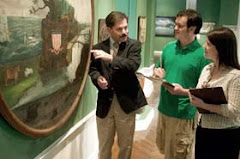Show figure carvers of the late nineteenth century were the most dynamic advertisers of their day. They created large, often life sized, sculptural figures for businesses to place on the sidewalk in front of their businesses to attract customers. Naturally, the carvers sought every advantage in capturing attention; in particular, they looked to popular culture to appropriate images that would be instantly recognizable. The life size figure of a Lady of Fashion in the Fenimore Art Museum collection is a great example of this phenomenon.
Generations of visitors to the museum have looked at this figure and asked, “Why does she have a squirrel on her head?” The answer is a couple of layers deep. In the early 1870s, the printmaking firm of Nathaniel Currier and James Merritt Ives published a lithograph poking fun at women’s fashions of the times. The print, called “Girl of the Period,” showed a modern young woman in a fashionable dress (complete with bustle in the rear and the forward-leaning “Grecian Bend”) with a hat that seemingly included a live squirrel. The inclusion of the squirrel was meant to lampoon the use (over-use?) of animal fur in the extravagant hats of the era.
It’s worth noting that the young lady is also smoking a cigarette. Show figure carvers like Samuel Robb of New York (the artist who likely carved our figure) catered mainly to establishments that sold tobacco. The most ubiquitous figures for advertising tobacconists’ shops was, of course, the cigar store Indian. But by the 1870s the carvers had gotten much more creative in an attempt to catch the attention of a public that had gotten used to the Native American figures. Hence, the plethora of new figures that included everything from baseball players to Santa Claus.
The demand for these figures can be judged by the output of the carving shops. Robb’s main competitor (and former teacher), Thomas V. Brooks of New York, advertised that his shop could produce about 200 figures a year, and he always had about 100 figures on the showroom floor at any one time. The figures went out to locations across the country, where they graced the sidewalks of small towns and cities just about everywhere.
Although most commercial folk art forms from the nineteenth century were replaced by technology (such as the camera, which eliminated the need for folk portraiture), these show figures had a very different nemesis: they were legislated out of existence. By the turn of the century, new ordinances designed to make urban areas safer and cleaner banned large obstructions from sidewalks. Untold numbers of these great carvings were discarded. A lucky few were collected by visionaries who saw their artistic value and importance to a national culture that was rapidly disappearing.



































